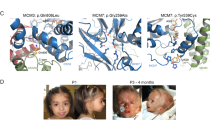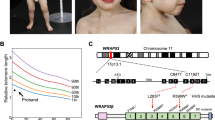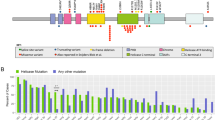Abstract
Rothmund-Thomson syndrome (RTS; also known as poikiloderma congenitale) is a rare, autosomal recessive genetic disorder characterized by abnormalities in skin and skeleton, juvenile cataracts, premature ageing and a predisposition to neoplasia1,2,3,4. Cytogenetic studies indicate that cells from affected patients show genomic instability often associated with chromosomal rearrangements causing an acquired somatic mosaicism5,6,7,8,9. The gene(s) responsible for RTS remains unknown. The genes responsible for Werner10 and Bloom11 syndromes (WRN and BLM, respectively) have been identified as homologues of Escherichia coli RecQ, which encodes a DNA helicase12 that unwinds double-stranded DNA into single-stranded DNAs. Other eukaryotic homologues thus far identified are human RECQL (Refs 13, 14), Saccharomyces cerevisiae SGS1 (Refs 15,16) and Schizosaccharomyces pombe rqh1+ (ref. 17). We recently cloned two new human helicase genes, RECQL4 at 8q24.3 and RECQL5 at 17q25, which encode members of the RecQ helicase family18. Here, we report that three RTS patients carried two types of compound heterozygous mutations in RECQL4. The fact that the mutated alleles were inherited from the parents in one affected family and were not found in ethnically matched controls suggests that mutation of RECQL4 at human chromosome 8q24.3 is responsible for at least some cases of RTS.
This is a preview of subscription content, access via your institution
Access options
Subscribe to this journal
Receive 12 print issues and online access
$209.00 per year
only $17.42 per issue
Buy this article
- Purchase on Springer Link
- Instant access to full article PDF
Prices may be subject to local taxes which are calculated during checkout


Similar content being viewed by others
Accession codes
References
Rothmund, A. Uber cataracten in verbindung mit einer eigenthumlichen hautdegeneration. Arch. Klin. Exp. Ophthal. 4, 159– 182 (1868).
Thomson, M.S. Poikiloderma congenitale. Br. J. Dermatol. 48, 221–234 (1936).
Vennos, E.M., Collins, M. & James, W.D. Rothmund-Thomson syndrome: review of the world literature. J. Am. Acad. Dermatol. 27, 750– 762 (1992).
Vennos, E.M. & James, W.D. Rothmund-Thomson syndrome. Dermatol. Clin. 13, 143–150 (1995).
Ying, K.L., Oizumi, J. & Curry, C.J.R. Rothmund-Thomson syndrome associated with trisomy-8 mosaicism. J. Med. Genet. 27, 258– 260 (1990).
Der Kaloustian, V.M., McGill, J.J., Vekemans, M. & Kopelman, H.R. Clonal lines of aneuploid cells in Rothmund-Thomson syndrome. Am. J. Med. Genet. 37, 336–339 (1990).
Orstavik, K.H., McFadden, N., Hagelsteen, J., Ormerod, E. & Van der Hagen, C.B. Instability of lymphocyte chromosomes in a girl with Rothmund-Thomson syndrome. J. Med. Genet. 31, 570–572 ( 1994).
Miozzo, M. et al. Chromosomal instability in fibroblasts and mesenchymal tumors from 2 sibs with Rothmund-Thomson syndrome. Int. J. Cancer 77, 504–510 (1998).
Lindor, N.M. et al. Rothmund-Thomson syndrome in siblings: evidence for acquired in vivo mosaicism. Clin. Genet. 49, 124–129 (1996).
Yu, C.-E. et al. Positional cloning of the Werner's syndrome gene. Science 272, 258–262 ( 1996).
Ellis, N.A. et al. The Bloom's syndrome gene product is homologous to RecQ helicases. Cell 83, 655–666 (1995).
Nakayama, K., Irino, N. & Nakayama, H. The recQ gene of Escherichia coli K12: molecular cloning and isolation of insertion mutants. Mol. Gen. Genet. 200, 266–271 ( 1985).
Seki, M. et al. Molecular cloning of cDNA encoding human DNA helicase Q1 which has homology to Escherichia coli RecQ helicase and localization of the gene at chromosome 12p12. Nucleic Acids Res. 22 , 4566–4573 (1994).
Puranam, K.L. & Blackshear, P.J. Cloning and characterization of RECQL, a potential human homologue of the Escherichia coli DNA helicase RecQ. J. Biol. Chem. 269, 29838– 29845 (1994).
Gangloff, S., McDonald, J.P., Bendixen, C., Arthur, L. & Rothstein, R. The yeast type I topoisomerase Top3 interacts with Sgs1, a DNA helicase homolog: a potential eukaryotic reverse gyrase. Mol. Cell. Biol. 14, 8391– 8398 (1994).
Watt, P.M., Louis, E.J., Borts, R.H. & Hickson, I.D. Sgs1: a eukaryotic homolog of E. coli RecQ that interacts with topoisomerase II in vivo and required for faithful chromosome segregation. Cell 81, 253–260 ( 1995).
Stewart, E., Chapman, C.R., Al-Khodairy, F., Carr, A.M. & Enoch, T. rqh1+, a fission yeast gene related to the Bloom's and Werner's syndrome genes, is required for reversible S phase arrest. EMBO J. 16, 2682–2692 (1997).
Kitao, S., Ohsugi, I., Goto, M., Furuichi, Y. & Shimamoto, A. Cloning of two new human helicase genes of the RecQ family: biological significance of multiple species in higher eukaryotes. Genomics 54, 443–452 (1998).
Yamagata, K. et al. Bloom's and Werner's syndrome genes suppress hyperrecombination in yeast sgs1 mutant: implication for genomic instability in human diseases. Proc. Natl Acad. Sci. USA 95, 8733–8738 (1998).
Acknowledgements
We thank S. Tahara, G.A. Coetzee and B.E. Henderson for advice and for providing us with the chromosomal DNAs from individuals of Mexican and European ancestries. This work was supported by the Drug Organization (The Organization for Drug ADR Relief, R and D Promotion and Product Review) of the Japanese Government.
Author information
Authors and Affiliations
Corresponding author
Rights and permissions
About this article
Cite this article
Kitao, S., Shimamoto, A., Goto, M. et al. Mutations in RECQL4 cause a subset of cases of Rothmund-Thomson syndrome. Nat Genet 22, 82–84 (1999). https://doi.org/10.1038/8788
Received:
Accepted:
Issue Date:
DOI: https://doi.org/10.1038/8788
This article is cited by
-
Continuous millisecond conformational cycle of a DEAH box helicase reveals control of domain motions by atomic-scale transitions
Communications Biology (2023)
-
Clinical challenges in interpreting multiple pathogenic mutations in single patients
Hereditary Cancer in Clinical Practice (2021)
-
Comparison of the fertility of tumor suppressor gene-deficient C57BL/6 mouse strains reveals stable reproductive aging and novel pleiotropic gene
Scientific Reports (2021)
-
RNF8 ubiquitinates RecQL4 and promotes its dissociation from DNA double strand breaks
Oncogenesis (2021)
-
Somatic and germline analysis of a familial Rothmund–Thomson syndrome in two siblings with osteosarcoma
npj Genomic Medicine (2020)



